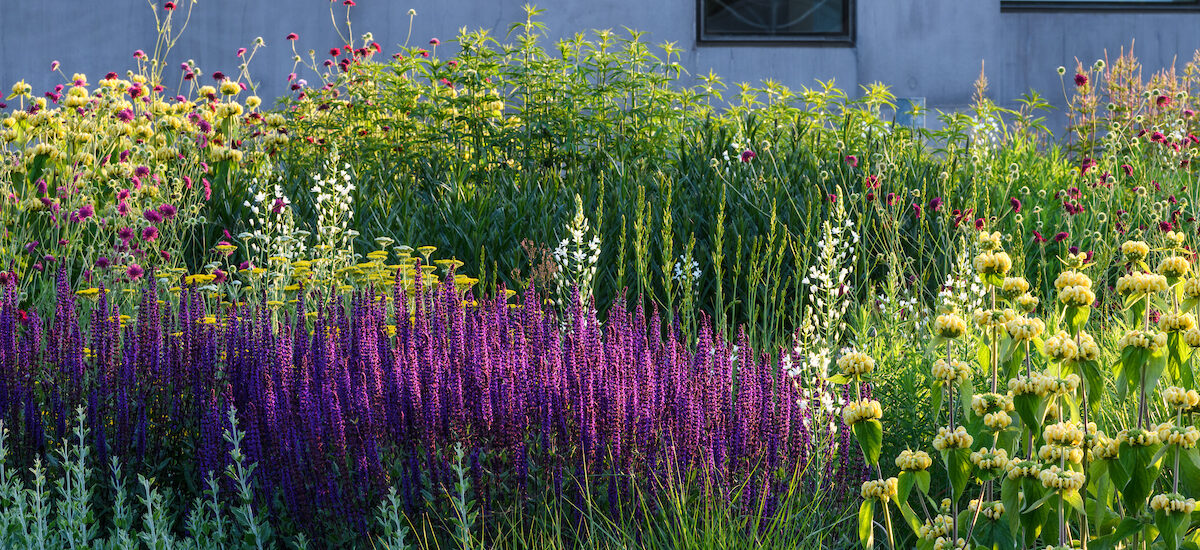Katy Merrington: What’s a Cultural Gardener?
STORIES

By Katy Merrington, Cultural Gardener at The Hepworth Wakefield
In 2019 The Hepworth Wakefield – an art gallery and creative space in the heart of Yorkshire – transformed an unloved piece of ground adjacent to the building, into a free public garden designed by Tom Stuart-Smith. Walking through this flower-filled oasis this morning, with children playing and people soaking in the sunshine on the benches, it is tricky to remember what the space was like before. Just a blank rectangular piece of council mown lawn, with a diagonal line eroded across it, where local residents cut the corner to the shopping park. It was a non-place, no reason to stop there, no hint of the warm welcome that you’d receive inside the art gallery. The team at The Hepworth Wakefield used to look out the window at this emptiness and envision a beautiful alternative, a garden where you could find peace amidst the busyness of the city. An accessible, friendly place, open 24 hours a day, where inspiration, creativity and colour could spill outside the architecturally imposing walls and be present in the city outside of opening hours. In commissioning the design competition for this new public garden, one of the fundamental elements that the gallery set in the design brief was that the planting must have as much year-round interest as possible. Dynamism as the seasons turned, so that you could walk through, week after week and always find something new to see. A fragrant scent on the breeze, a curious flower to make you pause and zoom in. Planting that would distil the moment and connect you with it.  From its inception the garden was also intended to be a home for sculpture, Barbara Hepworth the gallery’s namesake was born in Wakefield and inspired by the natural world around her. She preferred her sculpture to be shown outside. Saying ‘I think sculpture grows in the open light and with the movement of the sun its aspect is always changing.’ It has always struck me that the gallery has never referred to the space as a sculpture garden, but simply as a garden. It is home to a changing programme of public artworks, with pieces in place currently by Sir Michael Craig-Martin, Kim Lim, Halima Cassell and Barbara Hepworth. However, Tom Stuart-Smith’s planting design plays out like a living composition, in-conversation with the architecture and sculptures, but with such strength of character of its own, that the place has a singularity, allowing every element to contribute to a cohesive whole.
From its inception the garden was also intended to be a home for sculpture, Barbara Hepworth the gallery’s namesake was born in Wakefield and inspired by the natural world around her. She preferred her sculpture to be shown outside. Saying ‘I think sculpture grows in the open light and with the movement of the sun its aspect is always changing.’ It has always struck me that the gallery has never referred to the space as a sculpture garden, but simply as a garden. It is home to a changing programme of public artworks, with pieces in place currently by Sir Michael Craig-Martin, Kim Lim, Halima Cassell and Barbara Hepworth. However, Tom Stuart-Smith’s planting design plays out like a living composition, in-conversation with the architecture and sculptures, but with such strength of character of its own, that the place has a singularity, allowing every element to contribute to a cohesive whole.  Tom Stuart-Smith’s design takes inspiration from the unusual setting between the 19th-century red-brick mills and the 21st-century, Sir David Chipperfield designed art gallery. Meandering paths lead you through pads of planting, which almost seem to float between the hard landscaping. 3 separate lawns nestle amidst the flowers, with 52 trees and shrubs, helping to screen the road. The planting is made up of 14,000 herbaceous perennials, interwoven with 60,000 spring bulbs. Such that as one plant’s moment in the spotlight fades, another one picks up the baton, so that we have plants in flower from snowdrops in February through to fluffy Pennisetum in November. Beech hedges act like steel toe caps on the corner of the flower beds, encouraging you to wander round or peep over and providing a repeating motif in winter, when they hold their beautiful bronze leaves.
Tom Stuart-Smith’s design takes inspiration from the unusual setting between the 19th-century red-brick mills and the 21st-century, Sir David Chipperfield designed art gallery. Meandering paths lead you through pads of planting, which almost seem to float between the hard landscaping. 3 separate lawns nestle amidst the flowers, with 52 trees and shrubs, helping to screen the road. The planting is made up of 14,000 herbaceous perennials, interwoven with 60,000 spring bulbs. Such that as one plant’s moment in the spotlight fades, another one picks up the baton, so that we have plants in flower from snowdrops in February through to fluffy Pennisetum in November. Beech hedges act like steel toe caps on the corner of the flower beds, encouraging you to wander round or peep over and providing a repeating motif in winter, when they hold their beautiful bronze leaves. 


Gardens for Museums Conference: book tickets
Photos by Jason Ingram